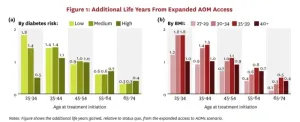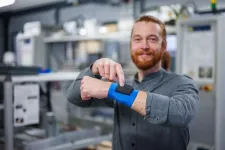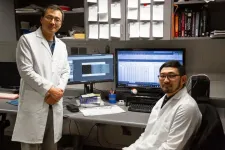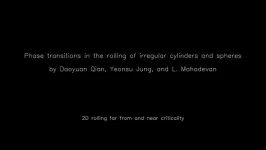(Press-News.org) If you just put away your phone to read this, chances are you’re not alone. Our phones are an endless source of distraction, and we interact with them every four to six minutes. This is often driven by habit as well as notifications, leading to a disrupted flow of activity while we’re trying to be productive.
A new study published in Frontiers in Computer Science investigated if placing smartphones just out of our reach while we’re at work influenced device use for activities not related to work.
“The study shows that putting the smartphone away may not be sufficient to reduce disruption and procrastination, or increase focus,” said the paper’s author Dr Maxi Heitmayer, a researcher at the London School of Economics. “The problem is not rooted within the device itself, but in the habits and routines that we have developed with our devices.”
Device vs distance
In the study, 22 participants were asked to work for two days in a private, soundproof room to which they brought the devices they usually have on them for work, a laptop and phone at a minimum. They did not change notification settings, and the notifications they received were in no way controlled by the researcher. Two settings that only differed by the distance between participant and their phone were explored: in the first, phones were placed on the desk participants were working from, in the second, the phone was placed on a separate desk 1.5 meters away.
Limited smartphone accessibility led to reduced smartphone use, but instead of becoming less distracted, participants shifted their attention to their laptops. Across conditions, participants did not spend different amounts of time on work or leisure activities.
In addition, the results showed that phones were the preferred device for distraction. “It’s your connection with loved ones and with work. It’s your navigation system, alarm clock, music player, and source of information. Unsurprisingly, people turn to the tool that does everything,” Heitmayer pointed out. “Even if you have no clear purpose, you know it has your socials and can provide entertainment.” While computers can fulfill the same functions, using one is less haptically pleasant, and they are not as handy and portable.
“In my research I want to shift the discourse beyond device-centric debates,” Heitmayer said. “The smartphone itself is not the problem. It’s what we do with it and, frankly, the apps that generate and reinforce these habits.”
Made to distract
To optimize time spent without distractions, notifications can be set to arrive at specific times or be silenced altogether. Any way that helps users be more mindful with their time is a step in the right direction, Heitmayer said. Despite these strategies, he cautioned that, realistically, we’re not stopping to pick up our phones anytime soon. “Whenever there is a small break, people check their phone, regardless of whatever system they have in place. And then there’s the socials, which is an entirely different beast.”
“There is a very unequal battle fought out every single day by each and every one of us when we use our phones,” Heitmayer continued. “The things inside phones that are the biggest attention sinks are developed by large corporations who greatly profit from our failure to resist the temptation to use them; all of this is literally by design.”
Heitmayer also said that in the future we should focus on protecting users, particularly young ones. “These devices are incredibly useful and can facilitate learning and creativity, but they come at a cost that most adults struggle to manage, so we simply cannot ignore this.”
END
Those constantly distracted by their phone will just find other ways to procrastinate if it isn’t nearby
A researcher put physical distance between people and their phones and found that our devices may not be the cause of our distraction – it’s what we do with them
2025-03-28
ELSE PRESS RELEASES FROM THIS DATE:
Ottoman Empire’s religious ‘tolerance’ another form of control
2025-03-28
Population surveillance. The carrying of identification while traveling. Add to that the public presence of diverse religions and it sounds like 2025, but this was life in the Ottoman Empire 200 years ago. Yet this seeming tolerance of non-Muslim faiths was in fact tied to the first two aspects, according to research by Osaka Metropolitan University Associate Professor Masayuki Ueno.
The Ottoman Empire lasted from around 1300 until 1922, and at various points in its history ruled present-day Turkey, Egypt, Greece, Hungary, and beyond. In the wake of the 1821 Greek revolt, the Ottoman Empire instituted ...
Smartphone bans alone fail to equip children for healthy use of technology
2025-03-27
Banning smartphone and social media access alone fails to equip children for healthy use of technology, argues a group of international experts in The BMJ today.
They say the focus should shift to a rights based approach, underpinned by age appropriate design and education, that protects children from harm while developing skills to help them participate in a digital society.
Bans on smartphone and social media access have been advocated in many countries to protect children from harm despite ...
Discovery of novel small compounds that delay flowering in plants
2025-03-27
Ikoma, Japan—In an era where climate change threatens food security, scientists worldwide are searching for reliable ways to improve crop production. Extreme weather and shifting seasonal patterns can disrupt traditional agricultural cycles, making technologies that regulate the timing of plant growth invaluable for farmers worldwide.
Plant growth and development are dependent on many factors such as the environment, photoperiod, and genetics. Flowering is an important event in a plant’s life ...
Expanding access to anti-obesity medications delivers 13% return on investment for society
2025-03-27
A new USC Schaeffer Center white paper finds expanded access to anti-obesity medications would lead to significant increases in life expectancy and disease-free years while generating a substantial societal return on investment, even after accounting for treatment costs.
More than 4 in 10 U.S. adults have obesity, which is linked to increased risk of over 200 diseases — including heart disease, diabetes, cancer and dementia — and costs society $260 billion annually to treat. Highly effective new anti-obesity medications can be a powerful tool against chronic disease, but fewer than one-third of health insurers cover them amid concerns about upfront ...
Genetic defense breakthrough: plants repurpose stomatal genes to fend off herbivores
2025-03-27
Ikoma, Japan—Throughout evolution, plants have continuously adapted to survive in changing environments. Apart from complex structural changes, plants have also developed various defense strategies against herbivores, including tougher protective layers, thorns, and chemical deterrents. Delving deeper into the evolution of defense mechanisms, a research team led by Assistant Professor Makoto Shirakawa from Nara Institute of Science and Technology (NAIST), identified a surprising genetic adaptation in the Brassicales plant order. In these cruciferous ...
David B. Allison, Ph.D., Daniel W. Belsky, Ph.D., and Arlan Richardson, Ph.D., to receive 2025 Scientific Awards of Distinction from the American Federation for Aging Research
2025-03-27
New York, NY — The American Federation for Aging Research (AFAR), is pleased to announce the 2025 recipients of three of its annual Scientific Awards of Distinction: David B. Allison, PhD, will receive the Irving S. Wright Award of Distinction; Daniel W. Belsky, PhD, will receive the Vincent Cristofalo Rising Star Award in Aging Research; and Arlan Richardson, PhD, will receive the George M. Martin Lifetime Achievement in Mentoring Award.
The Irving S. Wright Award of Distinction is named in honor of AFAR’s founder and recognizes exceptional contributions to basic ...
Pregnant women advised to avoid mentholated e-cigarettes
2025-03-27
RIVERSIDE, Calif. -- Vaping during pregnancy is becoming more common, but its impact on early human development is not well understood. A new study by scientists at the University of California, Riverside, now reports that the flavor chemical menthol used in electronic cigarettes could pose risks to a developing baby.
The study, published in STEM CELLS Translational Medicine, used human embryonic stem cells, or hESCs, to characterize early stages of embryonic development and examined how low concentrations of menthol affect important cellular processes.
The ...
Smart textiles and surfaces – How lightweight elastomer films are bringing tech to life
2025-03-27
Clothes that can mimic the feeling of being touched, touch displays that provide haptic feedback to users, or even ultralight loudspeakers. These are just some of the devices made possible using thin silicone films that can be precisely controlled so that they vibrate, flex, press or pull exactly as desired. And all done simply by applying an electrical voltage. The research teams at the Center for Mechatronics and Automation Technology in Saarbrücken (ZeMA) headed by Professors Stefan Seelecke and Paul Motzki (Saarland University) and John Heppe (htw saar – University of Applied Sciences ...
FAMU-FSU College of Engineering researchers create innovative microparticles that unlock new insights into protein degradation and immune cell behavior
2025-03-27
FAMU-FSU College of Engineering researchers have created a new method for studying protein degradation within immune cells that uses engineered microparticles to track and analyze degradation processes more effectively than traditional methods.
The work, which was published in ACS Applied Materials & Interfaces, has important implications for treating diseases such as cancer, Alzheimer’s disease and autoimmune disorders.
“There is a lot we still don’t know about how cells ingest and eliminate tissue debris or pathogens — the process ...
Getting the ball rolling
2025-03-27
How gravity causes a perfectly spherical ball to roll down an inclined plane is part of elementary school physics canon. But the world is messier than a textbook.
Scientists in the Harvard John A. Paulson School of Engineering and Applied Sciences (SEAS) have sought to quantitatively describe the much more complex rolling physics of real-world objects. Led by L. Mahadevan, the Lola England de Valpine Professor of Applied Mathematics, Physics, and Organismic and Evolutionary Biology in SEAS and FAS, they combined theory, simulations, and experiments to understand what happens when an imperfect, ...
LAST 30 PRESS RELEASES:
CHANGE-seq-BE finds off-target changes in the genome from base editors
The Journal of Nuclear Medicine Ahead-of-Print Tip Sheet: January 2, 2026
Delayed or absent first dose of measles, mumps, and rubella vaccination
Trends in US preterm birth rates by household income and race and ethnicity
Study identifies potential biomarker linked to progression and brain inflammation in multiple sclerosis
Many mothers in Norway do not show up for postnatal check-ups
Researchers want to find out why quick clay is so unstable
Superradiant spins show teamwork at the quantum scale
Cleveland Clinic Research links tumor bacteria to immunotherapy resistance in head and neck cancer
First Editorial of 2026: Resisting AI slop
Joint ground- and space-based observations reveal Saturn-mass rogue planet
Inheritable genetic variant offers protection against blood cancer risk and progression
Pigs settled Pacific islands alongside early human voyagers
A Coral reef’s daily pulse reshapes microbes in surrounding waters
EAST Tokamak experiments exceed plasma density limit, offering new approach to fusion ignition
Groundbreaking discovery reveals Africa’s oldest cremation pyre and complex ritual practices
First breathing ‘lung-on-chip’ developed using genetically identical cells
How people moved pigs across the Pacific
Interaction of climate change and human activity and its impact on plant diversity in Qinghai-Tibet plateau
From addressing uncertainty to national strategy: an interpretation of Professor Lim Siong Guan’s views
Clinical trials on AI language model use in digestive healthcare
Scientists improve robotic visual–inertial trajectory localization accuracy using cross-modal interaction and selection techniques
Correlation between cancer cachexia and immune-related adverse events in HCC
Human adipose tissue: a new source for functional organoids
Metro lines double as freight highways during off-peak hours, Beijing study shows
Biomedical functions and applications of nanomaterials in tumor diagnosis and treatment: perspectives from ophthalmic oncology
3D imaging unveils how passivation improves perovskite solar cell performance
Enriching framework Al sites in 8-membered rings of Cu-SSZ-39 zeolite to enhance low-temperature ammonia selective catalytic reduction performance
AI-powered RNA drug development: a new frontier in therapeutics
Decoupling the HOR enhancement on PtRu: Dynamically matching interfacial water to reaction coordinates
[Press-News.org] Those constantly distracted by their phone will just find other ways to procrastinate if it isn’t nearbyA researcher put physical distance between people and their phones and found that our devices may not be the cause of our distraction – it’s what we do with them






